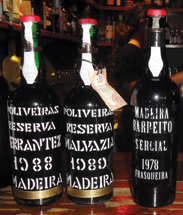
Time in a Bottle
A glass of madeira, anyone? The question is likely to be met with a blank stare in all but the most refined watering holes. In the minds of many, this more sophisticated older sister of port has been relegated to cooking wine and cheap grocery store varieties. But it was not always so..
Let’s start from the beginning. Madeira is wine from the island of the same name, a craggy speck of land in the middle of the Atlantic, 600 kilometers due west of North Africa. It was uninhabited until discovered in 1419 by Portuguese mariners, who promptly planted grapes on the steep, rocky hillsides. Madeira thrived in the Age of Discovery, becoming a regular port of call for ships heading to the New World. Not surprisingly, captains wanted to fill their holds with casks of wine. To keep it from spoiling during a long sea voyage, a small amount of spirits made from cane sugar was added. This boosted the alcohol content and gave it a unique taste which grew quite popular among sailors and landlubbers alike..
But then things got interesting. Wine merchants noticed that those casks which had been on the longest voyages were the most popular. That is to say, the sea voyage actually improved the taste of the wine, and it was auctioned off based upon the route, with casks going from England to India being the most expensive. But why?.
This question kicked off one of the touchiest debates of the time. Was it the constant movement of the ship through the waves, or the sweltering heat in the hold that gave it character? No doubt much madeira was consumed in attempts to answer this, for scientific reasons, of course. They figured out it was heat which “baked” the wine and preserved it. By then, brandy had replaced cane spirits, and the wine casks were stored in attics known as estufas where temperatures reached up to 140 degrees F..
Interestingly enough, the biggest customers for madeira were the thirsty American settlers. This began in 1665 when King Charles II married a Portuguese princess and gave the island a monopoly in selling wine to the colonies. Forget the Tea Party. When John Hancock’s sloop Liberty was seized over import duties carrying 25 casks of madeira, there were riots in Boston. George Washington is said to have consumed a pint at dinner daily, and Thomas Jefferson raised a glass of madeira to toast the Declaration of Independence. Benjamin Franklin introduced it to the French court at Versailles, and a bottle of madeira christened the USS Constitution in 1797..
So what happened? In the 19th century, the phylloxera epidemic that decimated European vineyards reached the island, and most of the vineyards were uprooted. Prohibition in America and revolution in Russia (it was a favorite of the Czar’s) wiped out its best markets. Sales of madeira plummeted, as did its reputation..
Which is no problem, because it leaves more for those of us in the know. I’ll have a glass of madeira anytime, but it’s generally drunk before or after a meal, as an aperitif or digestif, depending on the variety of grape used. The drier versions are known as sercial and verdelho. These have a pale color and a nutty aroma, just north of sherry. Malvasia (often known as malmsey) resembles port with a garnet color and a rich caramel taste that demands a Montecristo No. 4. My favorite is bual, somewhere in between (more on that later). You can have it before, during, or after dinner. Or skip dinner entirely..
One legacy of its seafaring past is that madeira is one of the longest-lived spirits. Madeiras have been known to survive over 150 years in excellent condition. There are vintages dating back to 1780 and a bottle from 1715 once came on the market. And there’s no need to drink it all at once---an opened bottle can survive for up to a year..
All this is wonderful, you say, but where can I get it? Even today, in cities like New York and London, it’s difficult to find a good bottle of madeira. A bit of research and a few Google searches will turn up wine merchants who share this obsession, but there’s no better excuse to go to Madeira, or at least Lisbon, where it’s plentiful. That’s what my old college roommate did, since what are old college roommates for? He brought me a truly breathtaking bottle of bual from Blandy’s, one of the island’s most august labels.Gracias, amigo..
Surprisingly affordable, it was from 1958, a very good year indeed. It graced my wine rack for a couple of weeks, awaiting a special occasion, but since none was at hand I went ahead and uncorked it. Held up to the light, it shone with an an agate-colored hue. You want to savor madeira and let it work its magic on you. The first hint was bitter but it soon mellowed and filled the room with a tangy bouquet. It softened with a taste that evoked raisins and toasted almonds and anis. And there was something else, a smoky aftertaste with just a whisper of rum and tobacco. Each sip took me further and further away, back in time to those Portuguese galleons bound for distant shores. Bom viagem.
